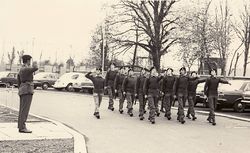History
The barracks were built on the Mahon Road in Portadown in 1972 to accommodate the 11th Battalion, Ulster Defence Regiment and were originally dubbed "Fort Mahon". [1] In February 1974 the barracks also became the Headquarters for 3rd Infantry Brigade where the brigade's units included, along with Brigade Staff, 174 (Provost) Company, Royal Military Police. [2]
The barracks were also the home of G Squadron, 22nd SAS Regiment and were the centre of many of their operations in Northern Ireland including the interception of eight members of a Provisional Irish Republican Army team at Loughgall RUC Barracks in 1987; [3] G Squadron operated under the working name of 4 Field Survey Troop, Royal Engineers. [4]
3rd brigade was moved to Drumadd Barracks in Armagh in 1988 during a restructuring of land forces in Northern Ireland. [5] In July 2000 the barracks were used by the security forces during the Drumcree conflict. [6]
The barracks were closed in January 2007. [7] The adjacent site to the South has since been marketed as a private housing development under the name "Maghon Park". [8]
This page is based on this
Wikipedia article Text is available under the
CC BY-SA 4.0 license; additional terms may apply.
Images, videos and audio are available under their respective licenses.

